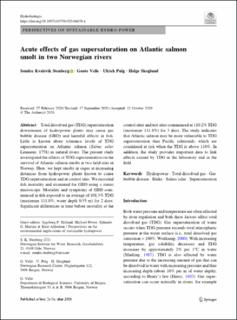| dc.contributor.author | Stenberg, Sondre Kvalsvik | |
| dc.contributor.author | Velle, Gaute | |
| dc.contributor.author | Pulg, Ulrich | |
| dc.contributor.author | Skoglund, Helge | |
| dc.date.accessioned | 2021-03-04T08:22:54Z | |
| dc.date.available | 2021-03-04T08:22:54Z | |
| dc.date.created | 2020-11-08T19:51:22Z | |
| dc.date.issued | 2020 | |
| dc.Published | Hydrobiologia. 2020, . | |
| dc.identifier.issn | 0018-8158 | |
| dc.identifier.uri | https://hdl.handle.net/11250/2731554 | |
| dc.description.abstract | Total dissolved gas (TDG) supersaturation downstream of hydropower plants may cause gas bubble disease (GBD) and harmful effects in fish. Little is known about tolerance levels of TDG supersaturation on Atlantic salmon (Salmo salar Linnaeus, 1758) in natural rivers. The present study investigated the effects of TDG supersaturation on the survival of Atlantic salmon smolts at two field sites in Norway. Here, we kept smolts in cages at increasing distances from hydropower plants known to cause TDG supersaturation and at control sites. We recorded fish mortality and examined for GBD using a stereo microscope. Mortality and symptoms of GBD commenced in fish exposed to an average of 108.3% TDG (maximum 111.0%, water depth 0.55 m) for 2 days. Significant differences in time before mortality at the control sites and test sites commenced at 110.2% TDG (maximum 111.8%) for 3 days. The study indicates that Atlantic salmon may be more vulnerable to TDG supersaturation than Pacific salmonids, which are considered at risk when the TDG is above 110%. In addition, the study provides important data to link effects caused by TDG in the laboratory and in the field. | en_US |
| dc.language.iso | eng | en_US |
| dc.publisher | Springer | en_US |
| dc.rights | Navngivelse 4.0 Internasjonal | * |
| dc.rights.uri | http://creativecommons.org/licenses/by/4.0/deed.no | * |
| dc.title | Acute effects of gas supersaturation on Atlantic salmon smolt in two Norwegian rivers | en_US |
| dc.type | Journal article | en_US |
| dc.type | Peer reviewed | en_US |
| dc.description.version | publishedVersion | en_US |
| dc.rights.holder | Copyright The Author(s) 2020 | en_US |
| cristin.ispublished | true | |
| cristin.fulltext | original | |
| cristin.qualitycode | 1 | |
| dc.identifier.doi | 10.1007/s10750-020-04439-z | |
| dc.identifier.cristin | 1845943 | |
| dc.source.journal | Hydrobiologia | en_US |
| dc.relation.project | Norges forskningsråd: 294742 | en_US |
| dc.identifier.citation | Hydrobiologia, 2020. | en_US |

